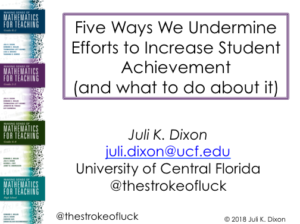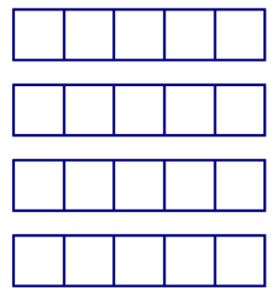Five Ways We Undermine Efforts to Increase Student Achievement
(and what to do about it!)
by Juli Dixon
Blog Post Part 5 of 5

I am excited to provide this fifth part in a five part series of posts unpacking the Ignite session I provided at the NCTM Annual. You can view the Ignite on the NCTM Annual website (https://www.nctm.org/annual/) beginning at timestamp 21:40.
This fifth potentially (Un)Productive Practice focuses on making the most of teaching rigorous standards. This fifth practice is the most nuanced of all. First, we need to make sense of rigor and how it is currently addressed in schools where efforts are in place to support it. Second, we need to acknowledge that it might not be working as well as we had hoped.

Rigor, as it relates to the shifts associated with recent state standards, is often defined as the need to include conceptual understanding, procedural skill, and application in mathematics teaching and learning. Those who embrace the idea that rigor is important have also come to understand that concepts need to be addressed before procedures. The key here is that students should make sense of the mathematics by exploring “the why” before they develop fluency – I guess this could be thought of as “the what”. Fractions provide a helpful context for unpacking this.
Consider the expression 4 ÷ 1/5. If students are taught the algorithm to keep the four (or in this case write it as the fraction 4/1), change the division to multiplication, and flip the 1/5 so it becomes 5/1 there is very little motivation to make sense of this algorithm as it relates to computing with fractions. In contrast, if students were provided with a word problem that could be modeled with this expression, access to the concept is more obvious.
Consider the following word problem:
I have four sticks of butter. If one mini-pan-sized chocolate chip cookie uses 1/5 stick of butter (I know – that isn’t much butter – but you get my point :), how many cookies can I make?
It would not be difficult for students to draw a representation of this problem. It would likely look something like this:

Students would see that 20 cookies could be made from 4 sticks of butter. This would be an important accomplishment. Students would understand that dividing by a fraction can be interpreted as determining the number of groups the size of that fraction they can make. This experience should certainly be provided prior to introducing the “invert and multiply” algorithm. However, this alone is not sufficient and we are beginning to see this as we examine data related to student achievement. According to anecdotal data, students are still demonstrating that they are not remembering algorithms or they are applying them incorrectly (this includes some students with I have recently worked with). What are we missing?
I think I have the answer! We are neglecting the connection. We need to continue teaching concepts before procedures but we need to do more than that. We have to be intentional about connecting them. We need to make the connection explicit. I will use the cookie problem to illustrate what I mean.
When we explored 4 ÷ 1/5 in context, we saw that we could make 5 cookies for each stick of butter because there are 5 one-fifths in each whole stick. Since there were four sticks of butter we could conclude that there were four groups of five so 20 cookies could be made in all. Another way to model four group of five is 4 x 5. Therefore, 4 ÷ 1/5 was solved by finding 4 x 5.
What if the cookie recipe called for 2/5 stick of butter? Rather than being able to make 20 cookies from four sticks of butter, only 10 cookies could be made. Since each cookie used twice as much better, half of the number of cookies could be made. This can be represented by dividing the original product by two. Therefore, 4 ÷ 2/5 is solved by finding 4 x 5 ÷ 2. This is not exactly the same as how the algorithm is typically described but it is more clearly connected to the concept of dividing by a fraction. And, as students become comfortable connecting their new understanding of dividing fractions to this computation, instruction can be used to link this procedure to the standard algorithm of invert and multiply.
What is important here is that students will be more likely to remember how (and when) to divide fractions because the procedure they use will be connected to what they have come to understand. It is during the lessons focused on making these connections that academic vocabulary should be introduced (see part 4 of this series for a more extensive conversation related to academic vocabulary).
This practice was more difficult to explain than I anticipated. I hope you will send any comments or questions you have my way by tweeting to @thestrokeofluck. Please keep the comments public so we can engage more mathematics educators in our discussion.
As with every post in this series, my goal is to support increases in student achievement for each and every learner. Because of this, I have come to realize that I should have shared SIX potentially (Un)Productive Practices. Because of this realization, I plan to share a sixth post in this five-part series within the next few weeks (would this qualify as a fraction greater than one? I’m sure we wouldn’t call it improper :). Stay tuned…
Please tweet your thoughts, comments, and ideas on this post to @thestrokeofluck
